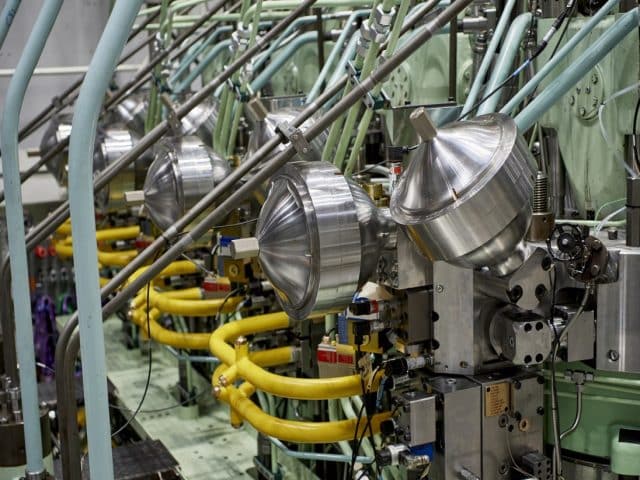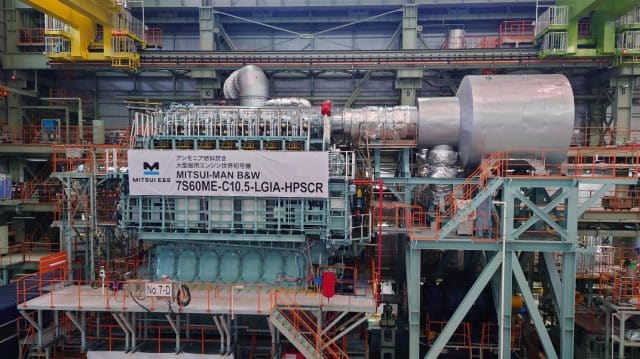Ammonia-fueled engines on the horizon
By Geofrey Njovu on March 11, 2025
WinGD: maximum load tests confirm low emissions output
At its Engine Research and Innovation Centre in Switzerland, engine developer WinGD has confirmed excellent performance and emission results for full-load, single-cylinder testing of its X-DF-A ammonia-fuelled engine design. The tests confirm that operation on ammonia achieved the same thermal efficiency as for diesel fuel, with pilot oil consumption at the targeted 5% amount.
Ammonia emissions (slip) was below 10ppm during testing, N2O below 3ppm, and NOX emissions well below those generated during diesel use. These low emissions were achieved without the use of exhaust gas after-treatment, and mean that no ammonia slip catalyst (ASC) will be required to operate the engine with ammonia fuel.
Our well-structured development approach has paid off. After intensive efforts to understand the principles of ammonia injection and combustion, we are the first two-stroke engine designer to demonstrate ammonia operation with 5% pilot fuel consumption and such low emissions.
Sebastian Hensel, Vice President Research & Development at WinGD in his organisation’s official press release, 13 Mar 2025
In January of this year WinGD began single-cylinder testing, which will enable full ammonia combustion system validation. Prior to single-cylinder tests, dedicated test rigs were used for combustion and critical systems validation, and for multiple safety approvals. The functional, mechanical behaviour and reliability of the ammonia fuel injectors of the X-DF-A engines were also validated. The injectors were also tested on a multi-cylinder methanol engine at 100% load to verify the ammonia injection under harsh conditions and thermal stress.
WinGD’s X-DF-A platform is based on the diesel-cycle concept innovated to run on ammonia with minimal and controlled emissions, and with extra safety measures to account for ammonia’s fuel characteristics. The company has about 30 orders already locked in from various segments including bulk carriers, containerships, tankers and LPG/ammonia carriers. First in line to be built are four Exmar LPG LPG/ammonia carrier engines and ten CMB.Tech-operated bulk carriers.
Maximum engine load testing for MAN ES ammonia dual fuel engine

Click to learn more. The under-testing ME-LGIA ammonia-fueled engine has run at 100% engine load for the first time with key results working according to plan. Source: MAN Energy Solutions.
MAN Energy Solutions (MAN ES) has also announced that its Man Energy Liquid Gas Injection Ammonia (ME-LGIA) engine, which is undergoing tests at its Research Centre Copenhagen (RCC) facility, has, for the first time, run at 100% engine load.
The company has reported that all supply and safety systems, as well as its proprietary selective catalytic reduction (SCR) which was operational at all test loads for exhaust gas treatment, worked according to plan. The next phase of the tests will focus on performance and emission optimisation, injection and SCR systems, and control strategies.
At our annual conference in New Orleans in November last year, MAN ES reported that their two-stroke ammonia-fueled engines may be ready for commercial deployment as early as towards the end of this year. This followed over 12 months of testing which showed stable combustion and virtually zero nitrous oxide (N2O) emissions.
We began full-scale testing in November 2024 and have since proceeded in a cautious and safety-first way. We have now operated the engine on ammonia from 25–100% load, marking yet another important step forward in the maritime energy transition. As such, we have now validated the ammonia fuel-injection system over the full load-curve with diesel-pilot amounts recorded according to our targets. Furthermore, the positive emission and performance characteristics from previous, single-cylinder tests have now also been validated in full-scale engine operation.
Ole Pyndt Hansen, Head of Two-Stroke R&D, MAN Energy Solutions, in his organisation’s official press release, 30 January 2025
Commercial prototype testing for MITSUI-MAN ES ammonia dual fuel engine

Click to learn more. The MITSUI-MAN large bore, low speed commercial scale ammonia dual fuel engine is currently undergoing operational tests at Mitsui’s Tamano factory in Japan. Source: MITSUI E&S.
MITSUI E&S has commenced the test operation of a large-bore, low-speed, two-stroke commercial ammonia dual fuel engine (the MITSUI-MAN B&W 7S60ME-C10.5LGIA-HPSCR) at its Tamano Factory in Japan. The prototype tests will build on MAN ES’ single-cylinder and full-engine ammonia-fueled tests at its Copenhagen-based two-stroke research centre.
The engine, developed by MAN ES, contains 7 cylinders and has a continuous power output of 17430 kW, operating at 105 revolutions per minute. The MITSUI press release cites the test as the “world’s first” for a large-bow low-speed ammonia engine at this scale.
Along with the engine tests, MITSUI is developing the peripheral equipment thanks to support from the New Energy and Industrial Technology Development Organization (NEDO) under its “Integrated project for development and social implementation of ammonia-fueled ships”. The test run will focus on assessing the performance and safety of the ammonia supply system and the under-development peripheral systems.